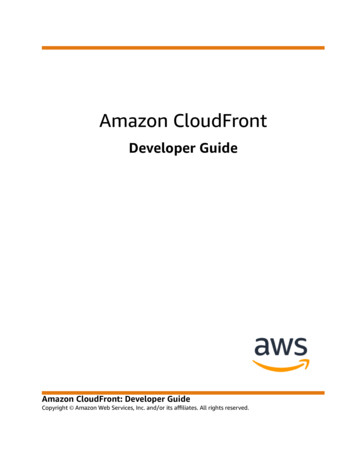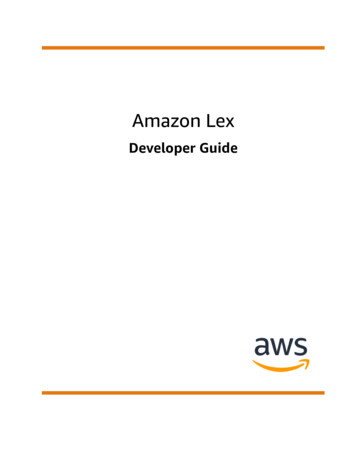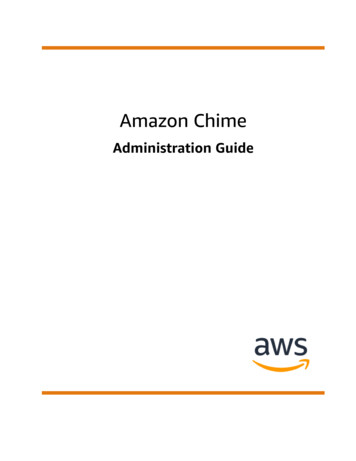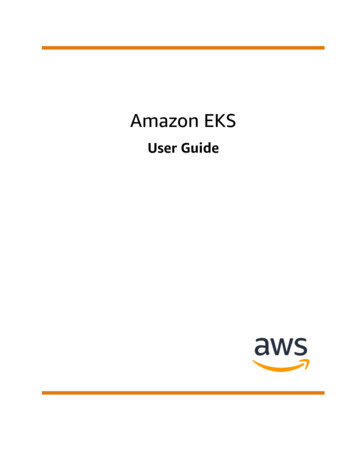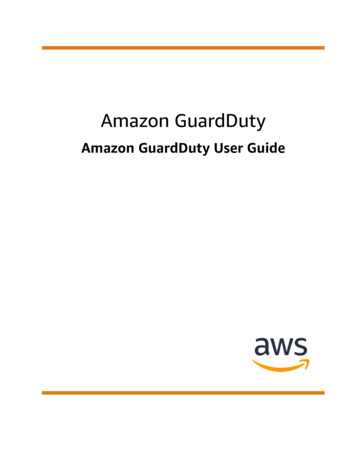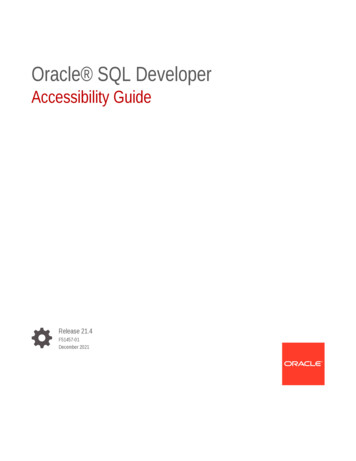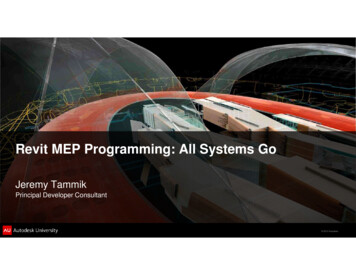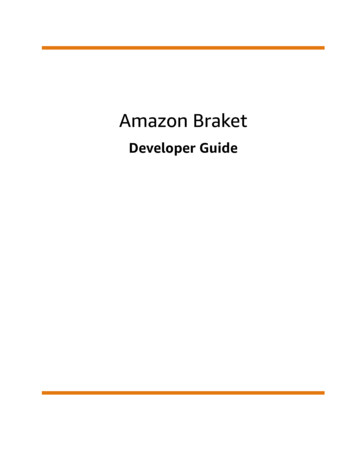
Transcription
Amazon BraketDeveloper Guide
Amazon Braket Developer GuideAmazon Braket: Developer GuideCopyright 2020 Amazon Web Services, Inc. and/or its affiliates. All rights reserved.Amazon's trademarks and trade dress may not be used in connection with any product or service that is notAmazon's, in any manner that is likely to cause confusion among customers, or in any manner that disparages ordiscredits Amazon. All other trademarks not owned by Amazon are the property of their respective owners, who mayor may not be affiliated with, connected to, or sponsored by Amazon.
Amazon Braket Developer GuideTable of ContentsWhat Is Amazon Braket? . 1AmazonBraket terms and concepts . 2AWS terminology and tips for AmazonBraket . 4How it works . 5AmazonBraket task flow . 5Third-party data processing . 6Supported devices . 7IonQ . 9Rigetti . 9OQC . 10D-Wave . 10Xanadu . 10Local state vector simulator (braket sv) . 10Local density matrix simulator (braket dm) . 11State vector simulator (SV1) . 11Density matrix simulator (DM1) . 12Tensor network simulator (TN1) . 13PennyLane’s lightning simulators . 13Compare simulators . 14Regions and endpoints . 17Pricing . 19Near real-time cost tracking . 19Best practices for cost savings . 20Quotas . 22Additional quotas and limits . 25When will my task run? . 26Status change notifications in email or SMS . 26QPU availability windows and status . 26Enable Amazon Braket . 27Prerequisites . 27Steps to enable Amazon Braket . 27Enable third-party devices . 29Get started . 30Create an AmazonBraket notebook instance . 30Run your first circuit using the AmazonBraket Python SDK . 32Run your first annealing problem with Ocean . 35Work with Amazon Braket . 38Construct circuits in the SDK . 39Gates and circuits . 39Manual qubit allocation . 42Verbatim compilation . 43Noise simulation . 44Inspecting the circuit . 44Result types . 46Run your circuits with OpenQASM 3.0 . 48What is OpenQASM 3.0? . 49When to use OpenQASM 3.0 . 49How OpenQASM 3.0 works . 49Prerequisites . 49What OpenQASM features are supported by Braket? . 50Create and submit an example OpenQASM 3.0 task . 52Support for OpenQASM on different Braket Devices . 54Simulate noise with OpenQASM3 . 56Qubit rewiring with OpenQASM3 . 57iii
Amazon Braket Developer GuideVerbatim Compilation with OpenQASM3 . 58Braket Console . 58More resources . 58Submitting tasks to QPUs and simulators . 58Example tasks on AmazonBraket . 59Submitting tasks to a QPU . 62Running a task with the local simulator . 64Task batching . 64Set up SNS notifications (optional) . 65Monitoring and tracking tasks . 65Tracking tasks from the AmazonBraket SDK . 65Advanced logging . 67Monitoring tasks through the AmazonBraket console . 69Working with Boto3 . 70Enable the Amazon Braket Boto3 client . 70Configure AWS CLI profiles for Boto3 and the AmazonBraket SDK . 73Amazon Braket Hybrid Jobs . 75When to use Amazon Braket Hybrid Jobs . 75Run a job with Amazon Braket Hybrid Jobs . 76Create your first job . 77Inputs, outputs, environmental variables, and helper functions . 82Inputs . 83Outputs . 83Environmental variables . 84Helper functions . 84Save job results . 84Save and restart jobs using checkpoints . 86Define the environment for your algorithm script . 87Use hyperparameters . 88Configure the job instance to run your algorithm script . 89Cancel a job . 91Use Amazon Braket Hybrid Jobs to run a QAOA algorithm . 92Accelerate your hybrid workloads with embedded simulators from PennyLane . 95Using lightning.gpu for Quantum Approximate Optimization Algorithm workloads . 95Quantum machine learning and data parallelism . 97Build and debug a job with local mode . 99Bring your own container (BYOC) . 100Configure the default bucket in AwsSession . 102Interact with jobs directly using the API . 102Use PennyLane with Amazon Braket . 106Amazon Braket with PennyLane . 106Hybrid algorithms in Amazon Braket example notebooks . 107Hybrid algorithms with embedded PennyLane simulators . 108Security . 109Shared responsibility for security . 109Data protection . 109Data retention . 110Managing access to Amazon Braket . 110AmazonBraket resources . 110Notebooks and roles . 110About the AmazonBraketFullAccess policy . 111About the AmazonBraketJobsExecutionPolicy policy . 114Restrict user access to certain devices . 116Amazon Braket updates to AWS managed policies . 117Service-linked role . 118Service-linked role permissions for Amazon Braket . 118Resilience . 119iv
Amazon Braket Developer GuideCompliance validation .Infrastructure Security .Third Party Security .Troubleshoot .Access denied exception .A task is failing creation .An SDK feature does not work .A job fails due to an exceeded quota .Something stopped working in your notebook instance .Troubleshoot OpenQASM .Include statement error .Non-contiguous qubits error .Mixing physical qubits with virtual qubits error .Requesting result types and measuring qubits in the same program error .Classical and qubit register limits exceeded error .Box not preceded by a verbatim pragma error .Verbatim boxes missing native gates error .Verbatim boxes missing physical qubits error .The verbatim pragma is missing "braket" error .Single qubits cannot be indexed error .The physical qubits in a two qubit gate are not connected error .GetDevice does not return OpenQASM results error .Local simulator support warning .VPC endpoints (PrivateLink) .Considerations for AmazonBraket VPC endpoints .Set up Braket and PrivateLink .Step 1: Launch an Amazon VPC if needed .Step 2: Create an interface VPC endpoint for Braket .Step 3: Connect and run Braket tasks through your endpoint .More about creating an endpoint .Control access with Amazon VPC endpoint policies .Tagging resources .Using tags .More about AWS and tags .Supported resources in AmazonBraket .Tag restrictions .Managing tags in AmazonBraket .Add tags .View tags .Edit tags .Remove tags .Example of CLI tagging in AmazonBraket .Tagging with the AmazonBraketAPI .Monitor with CloudWatch .Amazon Braket Metrics and Dimensions .Supported Devices .Amazon Braket Events with EventBridge .Monitor task status with EventBridge .Example AmazonBraket EventBridge event .Logging with CloudTrail .AmazonBraket Information in CloudTrail .Understanding AmazonBraket Log File Entries .API and SDK Reference .Document history 39139140142143
Amazon Braket Developer GuideWhat Is Amazon Braket?Amazon Braket is a fully-managed AWS service that helps researchers, scientists, and developers getstarted with quantum computing. Quantum computing has the potential to solve computationalproblems that are beyond the reach of classical computers, because it harnesses the laws of quantummechanics to process information in new ways.Gaining access to quantum computing hardware can be expensive and inconvenient. Limited accessmakes it is difficult to run algorithms, optimize designs, evaluate the current state of the technology, andplan for when to invest your resources for maximum benefit. Amazon Braket helps you overcome thesechallenges.Amazon Braket offers a single point of access to a variety of quantum computing technologies. It enablesyou to: Explore and design quantum and hybrid algorithms Test algorithms on different quantum circuit simulators Run algorithms on different types of quantum computers Create proof of concept applicationsDefining quantum problems and programming quantum computers to solve them requires a new setof skills. To help you gain these skills, Amazon Braket offers different environments to simulate and runyour quantum algorithms. You can find the approach that best suits your requirements, and you can getstarted quickly with a set of example environments, called notebooks.Amazon Braket development has three aspects — Build, Test, and Run:Build - Amazon Braket provides fully-managed Jupyter notebook environments that make it easyto get started. Amazon Braket notebooks are pre-installed with sample algorithms, resources, anddeveloper tools, including the Amazon Braket SDK. With the Amazon Braket SDK, you can build quantumalgorithms, then test and run them on different quantum computers and simulators by changing a singleline of code.Test - Amazon Braket provides access to fully-managed, high-performance, quantum circuit simulators.You can test and validate your circuits. Amazon Braket handles all the underlying software componentsand EC2 clusters to take away the burden of simulating quantum circuits on classical HPC infrastructure.Run - Amazon Braket provides secure, on-demand access to different types of quantum computers.You have access to gate-based quantum computers from IonQ and Rigetti, as well as a quantumannealer from D-Wave. You have no upfront commitment, and no need to procure access with individualproviders.About quantum computing and Amazon BraketQuantum computing is in early developmental stages. It’s important to understand that no universal,fault-tolerant quantum computer exists at present. Therefore, certain types of quantum hardware arebetter suited for certain use cases, and it is crucial to have access to a variety of computing hardware.Amazon Braket offers a variety of hardware, through third-party providers.Existing quantum hardware is limited due to noise, which introduces errors. The industry is in the NoisyIntermediate Scale Quantum (NISQ) era. In the NISQ era, quantum computing devices are too noisy tosustain pure quantum algorithms, such as Shor’s algorithm or Grover’s algorithm. Until better quantum1
Amazon Braket Developer GuideAmazonBraket terms and conceptserror correction is available, the most practical quantum computing requires the combination of classical(traditional) computing resources with quantum computers, to create hybrid algorithms. Amazon Brakethelps you work with hybrid quantum algorithms.In hybrid quantum algorithms, quantum processing units (QPUs) are used as co-processors for CPUs, thusspeeding up specific calculations in a classical algorithm. These algorithms utilize iterative processing, inwhich computation moves between classical and quantum computers. For example, current applicationsof quantum computing in chemistry, optimization, and machine learning are based on variationalquantum algorithms, which are a type of hybrid quantum algorithm. In variational quantum algorithms,classical optimization routines adjust the parameters of a parameterized quantum circuit iteratively,much in the same way the weights of a neural network are adjusted iteratively, based on the error ina machine learning training set. Amazon Braket offers access to the PennyLane open source softwarelibrary, which assists you with variational quantum algorithms.Quantum computing is gaining traction for computations in four main areas: Number theory — including factoring and cryptography. (For example, Shor’s algorithm is a primaryquantum method for number theory computations.) Optimization — including constraint satisfaction, solving linear systems, and machine learning. Oracular computing — including search, hidden subgroups, and order finding. (For example, Grover’salgorithm is a primary quantum method for oracular computations.) Simulation — including direct simulation, knot invariants, and quantum approximate optimizationalgorithm (QAOA) applications.Applications for these categories of computations can be found in financial services, biotechnology,manufacturing, and pharmaceuticals, to name a few. Amazon Braket offers capabilities and notebookexamples that can apply to many proof of concept problems, and certain practical problems, today.AmazonBraket terms and conceptsThe following terms and concepts are used in Amazon Braket:BraketWe named the Amazon Braket service after the bra-ket notation, a standard notation in quantummechanics. It was introduced by Paul Dirac in 1939 to describe the state of quantum systems, and itis also known as the Dirac notation.Quantum computerA quantum computer is a physical device that uses quantum-mechanical phenomena such assuperposition and entanglement to perform computations. There are different paradigms toquantum computing (QC), such as, gate-based QC or quantum annealing.QubitThe basic unit of information in a quantum computer is called a qubit (quantum bit), in analogyto classical bits. A qubit is a two-level quantum system that can be realized by different physicalimplementations, such as superconducting circuits, or individual ions and atoms. Other qubit typesare based on photons, electronic or nuclear spins, or more exotic quantum systems.Gate-based Quantum ComputingIn gate-based QC (also called circuit-based QC), computations are broken down into elementaryoperations (gates). It can be shown that certain sets of gates are universal, meaning that everycomputation can be expressed as a finite sequence of those gates. Gates are the building blocks ofquantum circuits, in analogy to the logic gates of classical digital circuits.2
Amazon Braket Developer GuideAmazonBraket terms and conceptsQuantum AnnealingQuantum annealing is a form of special purpose quantum computing that tries to utilize quantumfluctuations to find global minima of an objective function. In most approaches, the objectivefunction that is encoded directly in the physical couplings parameters of the qubits. Quantumannealing is mainly used for combinatorial optimization problems (e.g., QUBO problems), where onehas a finite and discrete search space.DeviceIn Amazon Braket, a device is a backend that can execute quantum tasks. A device can be a QPU or aquantum circuit simulator. To learn more, see AmazonBraket supported devices (p. 7).Quantum Circuit SimulatorA quantum circuit simulator is a computer program that runs on classical computers and calculatesthe measurement outcomes of a quantum circuit. For general circuits, the resource requirements ofa quantum simulation grows exponentially with the number of qubits to simulate. Amazon Braketprovides access to both managed (accessed through the Braket API) and local (part of the AmazonBraket SDK) quantum circuit simulators.Quantum Processing Unit (QPU)A QPU is a physical quantum computing device that can execute a quantum task. QPUs can bebased on different QC paradigms, e.g., gate-based QC or quantum annealing. To learn more, seeAmazonBraket supported devices (p. 7).Quantum CircuitA quantum circuit is the instruction set that defines a computation on a gate-based quantumcomputer. A quantum circuit is a sequence of
started with quantum computing. Quantum computing has the potential to solve computational problems that are beyond the reach of classical computers, because it harnesses the laws of quantum mechanics to process information in new ways. Gaining access to quantum computing hardware can be expensive and inconvenient. Limited access


![Index [beckassets.blob.core.windows ]](/img/66/30639857-1119689333-14.jpg)
